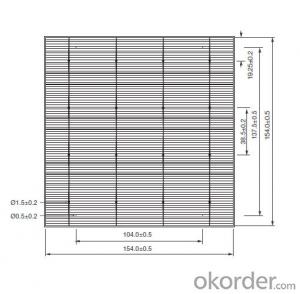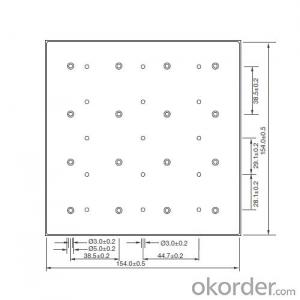Polycrystal solar Cell JAC P6WR-0 (MWT )
- Loading Port:
- China main port
- Payment Terms:
- TT OR LC
- Min Order Qty:
- 1000 watt
- Supply Capability:
- 1000000 watt/month
OKorder Service Pledge
OKorder Financial Service
You Might Also Like
JACP6WR-0 POLYCRYSTALLINE SILICON SOLAR CELL
JA solar's high effciency MWT poly cell, manufacturing modules with more than 265W(6x10)power putput becomes easier than ever.
Futures:
Format:156mmx156mm±0.5mm
thickness:210um±30um
Front:Blue anti-reflecting coating (silicon nitride)
back:31 contact pads in diameter 3mm
Data sheet


FAQ
We have organized several common questions for our clients,may help you sincerely:
①How about your company?
CNBM Solar photovoltaic (PV) Panel has various wattage from 1.5W to 315W to meet the demand of every customer. It is the optimal choice for both on-grid and off-grid power systems. CNBM Solar panel offers high performance of power warranty and good after sale service, we have professional people to reply your problem anytime.
CNBM International Corporation's products including Monocrystalline Solar Panel, Polycrystalline Solar Panel have received and enjoyed famous reputation in many countries and regions in the world .As a solar panel supplier in China, we strive to provide our customers with excellent service, superior products and unmatched value.
②How to guarantee the quality of the products?
CNBM Solar performance guarantees for 25 years
• 12 years guarantee for workmanship
• Timeliness of delivery
• Quality Products certified (TÜV, UL, CE, ISO)
③How long can we receive the product after purchase?
In the purchase of product within three working days, We will arrange the factory delivery as soon as possible. The pecific time of receiving is related to the state and position of customers.Commonly 7 to 10 working days can be served.
- Q:What is the impact of tree shading on solar cell efficiency?
- Tree shading can significantly reduce solar cell efficiency as it obstructs sunlight from reaching the cells. When trees cast shadows on solar panels, the panels receive less sunlight, resulting in decreased energy generation. This shading causes a decrease in the overall output of the solar array, reducing its efficiency and potentially impacting the viability of the solar power system as a whole.
- Q:How do solar cells perform in cloudy weather?
- Solar cells still generate electricity in cloudy weather, but their performance is reduced. Cloud cover reduces the amount of sunlight reaching the cells, resulting in decreased power output.
- Q:Can solar cells be used for powering remote communication towers?
- Yes, solar cells can indeed be used to power remote communication towers. Solar cells, also known as photovoltaic cells, convert sunlight into electricity, making them an ideal and sustainable solution for remote locations where traditional power sources may be unavailable or impractical. The consistent exposure to sunlight enables solar cells to generate electricity to power communication equipment, including antennas, transmitters, and receivers, ensuring uninterrupted connectivity in remote areas. Additionally, solar cells can be paired with battery storage systems to store excess energy generated during the day, providing a reliable power supply for communication towers even during nighttime or cloudy conditions.
- Q:How does the size of a solar cell affect its performance?
- The size of a solar cell directly affects its performance. Larger solar cells have a higher surface area, allowing them to capture more sunlight and generate more electricity. This results in a higher power output and overall performance compared to smaller solar cells.
- Q:Can solar cells be used to power remote locations?
- Yes, solar cells can be used to power remote locations. Solar cells convert sunlight into electricity, making them an ideal renewable energy source for areas that are not connected to the traditional power grid. They can be installed in remote locations to generate electricity and provide a reliable power supply. Additionally, solar cells are low-maintenance and have a long lifespan, making them a cost-effective solution for powering remote areas.
- Q:PV: the battery to the battery charge problem
- Battery affected. Then according to the volt-ampere characteristics of solar energy, we can know that the actual output power of the solar panel is less than its nominal power.
- Q:Can solar cells be used on wearable technology?
- Yes, solar cells can be used on wearable technology. They can be integrated into various devices such as smartwatches, fitness trackers, and even clothing to provide a sustainable source of power. This allows wearables to be charged using sunlight, reducing the dependency on traditional charging methods and increasing their mobility and convenience.
- Q:How do solar cells perform in regions with high levels of salt spray and corrosive environments?
- Solar cells generally do not perform well in regions with high levels of salt spray and corrosive environments. The salt particles can accumulate on the surface of the solar cells, leading to reduced efficiency and decreased performance. Additionally, the corrosive nature of the environment can cause damage to the materials and components of the solar cells, further impacting their functionality. To mitigate these issues, special protective coatings or materials can be used to enhance the durability and resistance of solar cells in such regions.
- Q:How can I calculate the cost of using solar cells if I put a fully-functional solar system in my house?
- Depends on how you define the "cost" of the solar cells, if you are only calculation the electricity you used, it really cost nothing.
- Q:How are solar cells different from solar panels?
- Solar cells are the basic building blocks of solar panels. While solar panels are composed of multiple solar cells interconnected to generate electricity, solar cells are individual units that directly convert sunlight into electricity.
1. Manufacturer Overview |
|
|---|---|
| Location | |
| Year Established | |
| Annual Output Value | |
| Main Markets | |
| Company Certifications | |
2. Manufacturer Certificates |
|
|---|---|
| a) Certification Name | |
| Range | |
| Reference | |
| Validity Period | |
3. Manufacturer Capability |
|
|---|---|
| a)Trade Capacity | |
| Nearest Port | |
| Export Percentage | |
| No.of Employees in Trade Department | |
| Language Spoken: | |
| b)Factory Information | |
| Factory Size: | |
| No. of Production Lines | |
| Contract Manufacturing | |
| Product Price Range | |
Send your message to us
Polycrystal solar Cell JAC P6WR-0 (MWT )
- Loading Port:
- China main port
- Payment Terms:
- TT OR LC
- Min Order Qty:
- 1000 watt
- Supply Capability:
- 1000000 watt/month
OKorder Service Pledge
OKorder Financial Service
Similar products
New products
Hot products
Related keywords




























